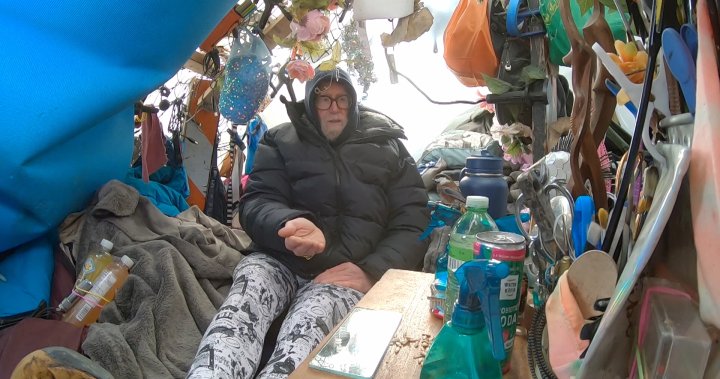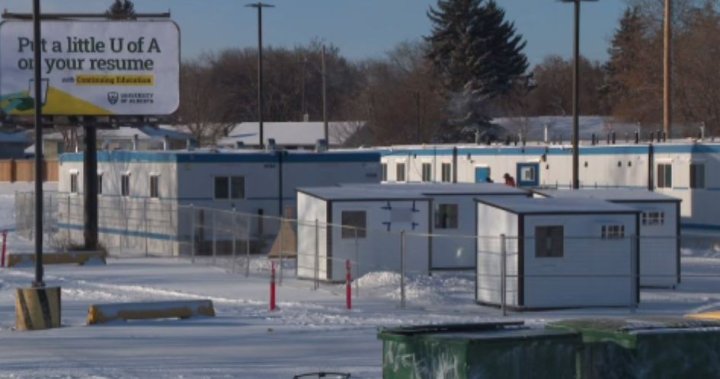This is the second story in a three-part series about a man who has lived in Vancouver’s Stanley Park for the last three decades. Read the first part here.
Christenson Bailey started camping in Stanley Park in 1990. And he still lives there today.
He’d moved into a tiny campsite hidden deep in the forest to make art for the last three decades, and he has lived on next to nothing.
In the beginning, Bailey survived on just $300 a year by putting his art skills to use, doing sign-writing jobs around the city for cash.
“By just doing this sporadically, coming in and out of the forest, no one ever questioned me,” Bailey tells Global News. “I just walked down the street, knocked on doors. I asked, ‘Would you like this?’ and showed them a presentation. People paid me a good fee.”
For the first 17 years, he lived only by candlelight. He made no trouble and kept in touch with park rangers. For food, he taught himself how to catch wild geese and ducks.
“It was easy to do,” he recalls. “Get some grain, go down to the water, throw the grain in the water, they show up, you bag one, pluck it, and you go down to the beach, build a fire and roast it.”
With a smile, he remembers the remoteness of that time, seeing virtually no one on Third Beach from sunset until early morning.
“The patterns of living and subsiding were basically what I was able to think up,” he says. “One of the happiest periods of my life was that period.”
This was how Bailey liked it.
He could go weeks without speaking to another person. He spent his time meditating, studying the forest, and making art.
When later years brought new technology, Bailey would ride his bike to UBC and spend up to 20 hours a week in the computer library building websites.
He went everywhere on his bike. He’d approach rental and repair shops to ask for old inner tubes from bike tires, which he’d discovered were perfect for tying bags to the front and back so he could carry things.
Sgt. Susan Sharp with the Vancouver Police Department’s Mounted Unit, whose stables are in Stanley Park, says Bailey was determined to be self-sufficient.
“He’s had numerous offers of clothing or food vouchers,” she says. “He never took anything from us. At one point, I got him a pair of shoes because his were so wet. He was very grateful.”
In a way, Bailey used the quiet forest to reset his life. It allowed him to remove all outside responsibilities and commitments so he could live a humble existence.
In one interview, he proudly states, “I have no time schedule, usually — except my own.”
He would spend hours or days at a time in the forest studying plants and animals. Walking along a trail with Global News, he points out a particular tree that forks at its midpoint.
“I think that’s an incredible tree, look at it,” he says. “The light that comes through, the feeling of peace and this presence, has so much quiet strength that it just resonates.”
This is where Bailey drew inspiration for making art, taking his sketchbook around the forest to see what he could create.
“You’re in this place … you’re not studying a book that says do this for tone and shade, or any teacher, instructor,” he says. “It’s between you and the natural world.”
For more than 25 years, Bailey sustained this lifestyle.
In 2017, things started to change.
Bailey would bathe regularly in a stream near his campsite. He believes the water was contaminated because he developed a skin condition and had to seek treatment from a clinic.
Given that he had no identification, he was referred to the Canadian Mental Health Association to be paired with a case worker — a routine process for someone considered to be living outside.
“From the outset, (the case worker) arranged for legal forms for me to sign, which swore that I was the person that I said I was.”
Caseworker Geoff Bodnerak had worked in various facets of outreach and mental health for 10 years when he met Bailey. They worked together for two.
“I run into a lot of individuals who aren’t afraid to be themselves,” Bodnerak says in an interview. “I enjoyed talking to (Bailey) and listening to his stories and how he grew up. I remember him bringing out his sketchbook and being very proud of his sketchbook.”
Through his connections, he secured Bailey a bank account, even without government identification, and initiated the process for a pension.
Within a few months, Bailey went from earning $300 a year to $600 a month.
He says he was “flabbergasted.”
He was able to buy groceries, better outdoor clothing, and a phone so he could start an Instagram account for his art.
Bodnerak says their relationship was always based on trust, and he never tried to convince Bailey to leave the park.
“That’s not what he wanted, he liked living there.”
At one point, Bailey ended up in the hospital for minor surgery after doctors found a benign tumour during an earlier assessment.
After the procedure, there was confusion around payment of the $1,000 bill.
“When it was apparent that it might not be covered, (Bodnerak) said he would pay for it,” Bailey recalls, with tears welling in his eyes. “You know, he was that kind of guy. He was great.”
By this point, Bailey had spent 27 years living in isolation in Stanley Park. No electricity, no heating, no creature comforts. Just himself and the natural world, with a visit to the city on occasion.
Bodnerak knew Bailey could live this way for many years to come, but steps needed to be taken for when, or if, he changed his mind. That started with getting a passport.
“(There was a) lot of investigative digging and it was just about where would they have medical records,” he says. Then they started looking at border-crossing records because his family had moved to Canada from the U.S. when he was a teenager.
“We started going through point of entry (records), and then I could prove he’s been in Canada this long.”
The process was long and slow. Bailey was one of about 100 clients Bodnerak had at the time.
Despite best efforts, the task was never completed. In 2019, Bodnerak left his job for personal reasons, handing over Bailey’s file to another worker.
Then the pandemic hit and Bailey’s case was no longer a priority.
So he waited.
Stay tuned for the final story in this three-part series.




